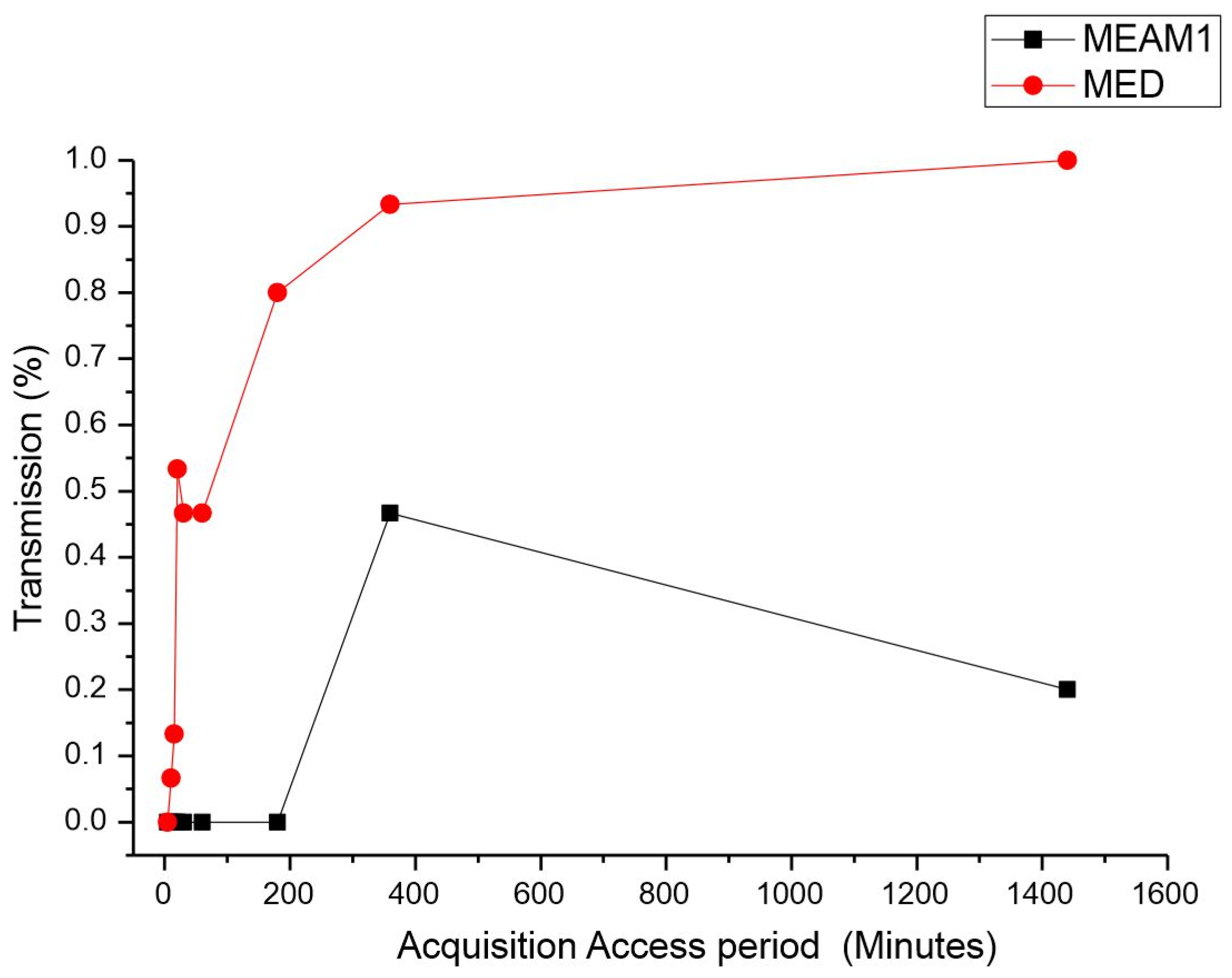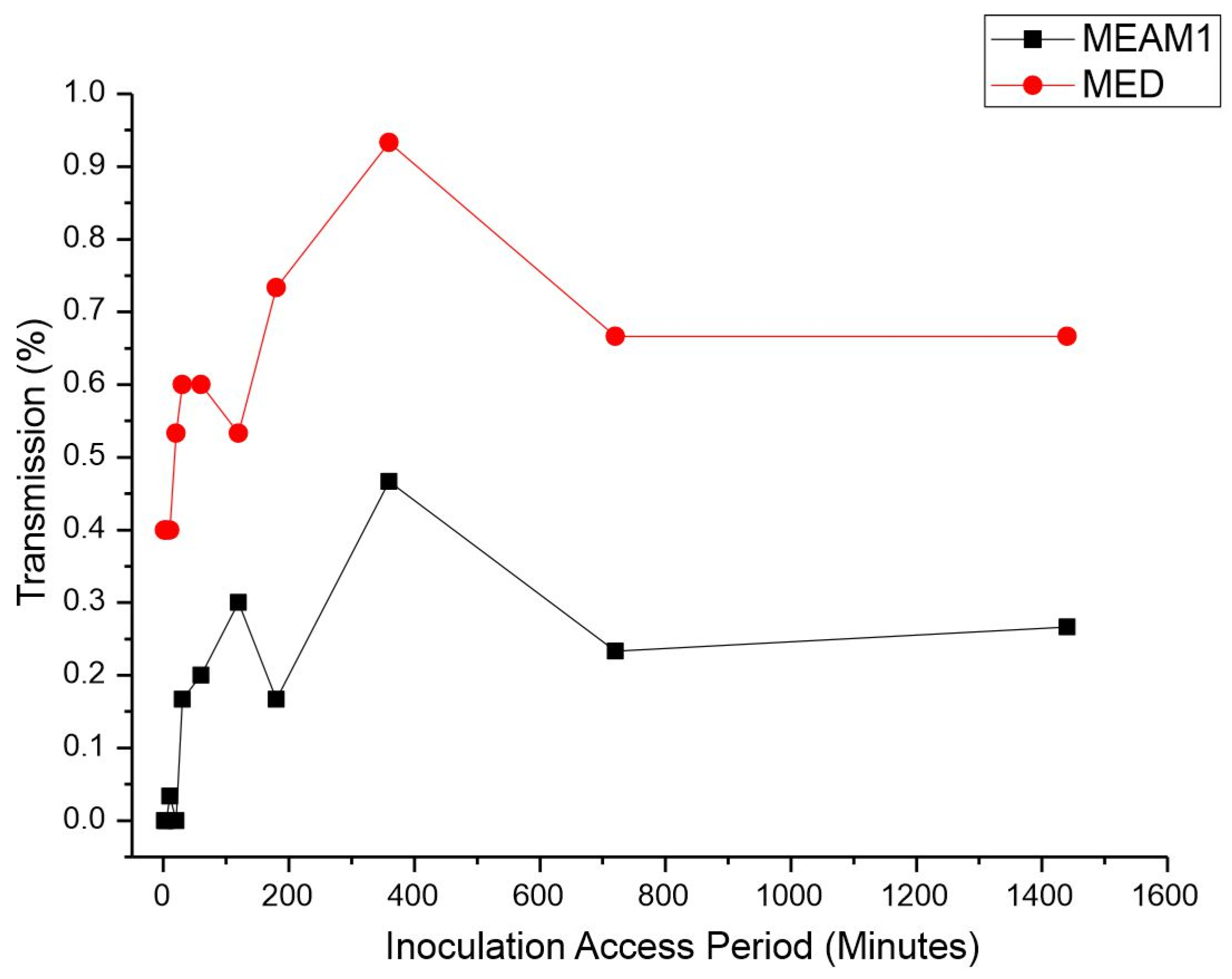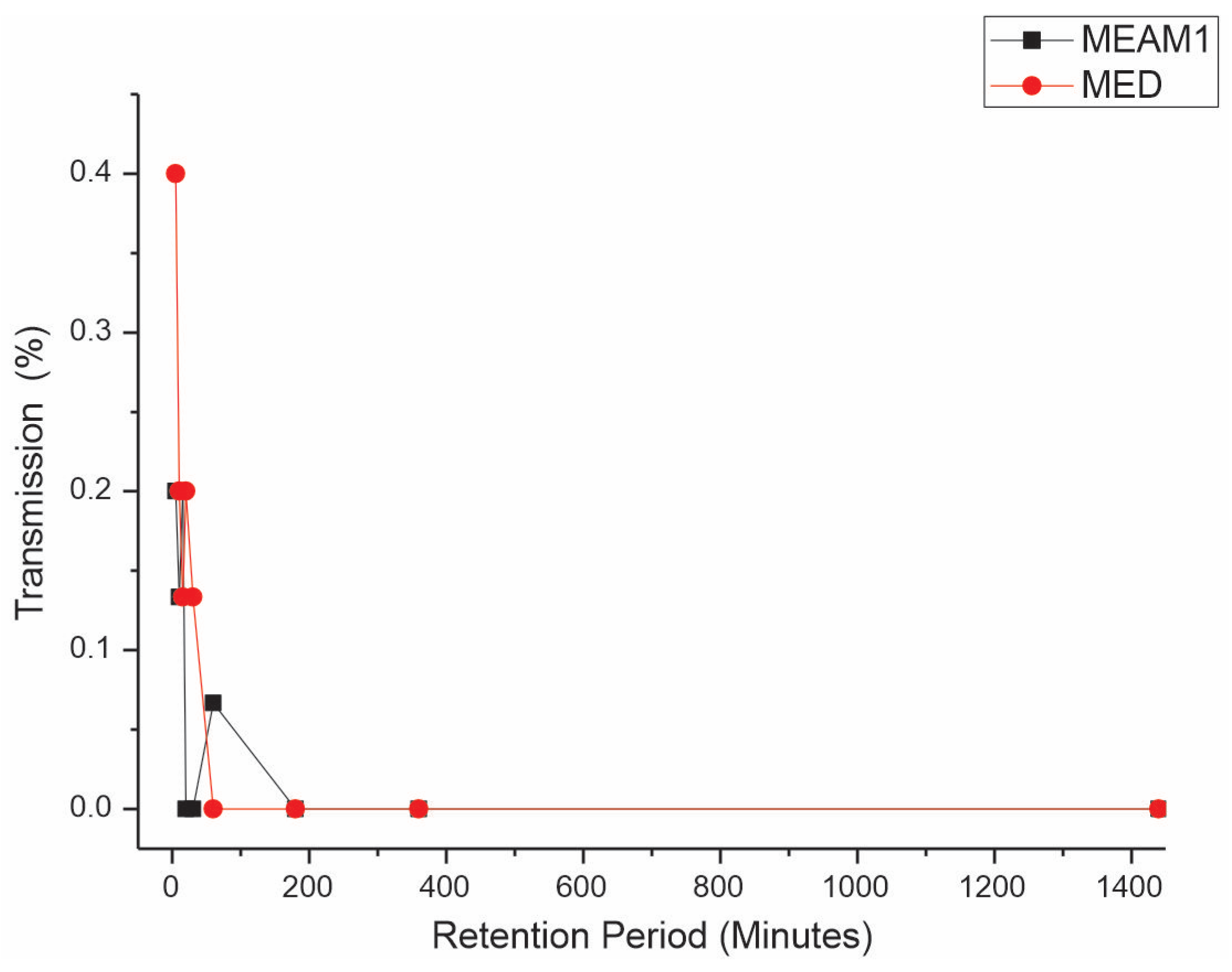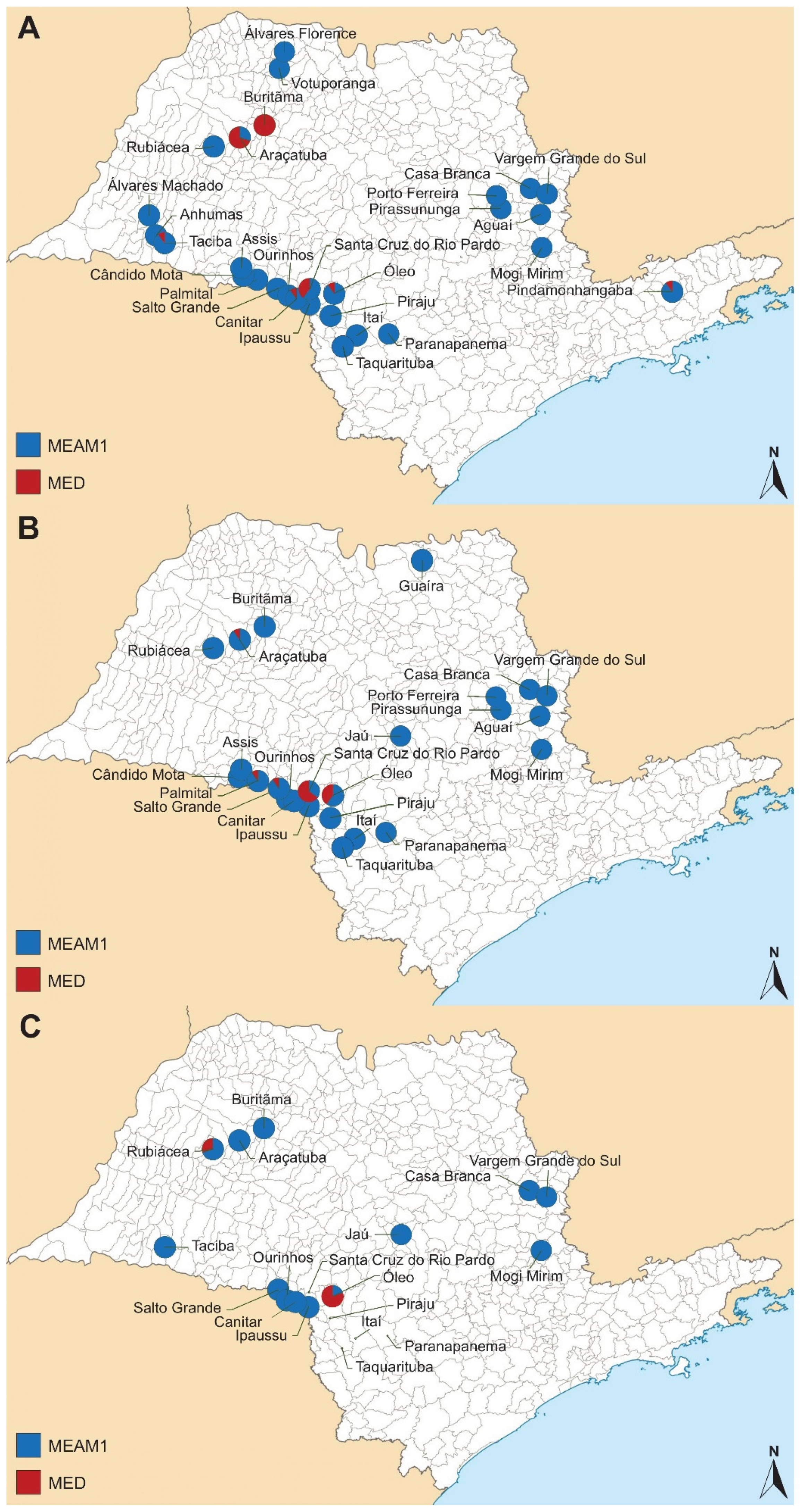Exploring Bemisia tabaci Middle East–Asia Minor I and Mediterranean Cryptic Species Relationship with Cowpea Mild Mottle Virus and Their Dynamics in Soybean Fields
Abstract
:Simple Summary
Abstract
1. Introduction
2. Material and Methods
2.1. Transmission Properties of CPMMV by Single B. tabaci MEAM1 and MED Insects
2.1.1. Insects
2.1.2. Plants
2.1.3. Acquisition Access Period (AAP)
2.1.4. Inoculation Access Period (IAP)
2.1.5. Retention Period (RP)
2.2. CPMMV RNA Extraction and Identification
2.3. Distribution of Whitefly Species on Major Soybean-Growing Areas in São Paulo State
2.4. Data Analysis
3. Results
3.1. Transmission of CPMMV by MEAM1 and MED on Soybean Using Single Insects
3.2. Whitefly Survey
4. Discussion
Supplementary Materials
Author Contributions
Funding
Data Availability Statement
Conflicts of Interest
References
- Costa, A.S.; Gaspar, J.O.; Vega, J. Mosaico Angular Do Feijão Jalo Causado Por Um Carlavírus Transmitido Pela Mosca Branca Bemisia tabaci. Fitopatol. Bras. 1983, 8, 325–327. [Google Scholar]
- Almeida, A.M.R.; Piuga, F.F.; Kitajima, E.W.; Gaspar, J.O.; Valentin, N.; Benato, L.C.; Marin, S.R.R.; Binneck, E.; de Oliveira, T.G.; Belitani, P. Necrose Da Haste Da Soja. Ser. Doc. 2003, 221, 1–48. [Google Scholar]
- Almeida, A.M.R. Viroses Da Soja No Brasil: Sintomas, Etiologia e Controle. Ser. Doc. 2008, 306, 1–62. [Google Scholar]
- Zanardo, L.; Silva, F.; Lima, A.; Milanesi, D.; Castilho-Urquiza, G.; Almeida, A.; Zerbini, F.; Carvalho, C. Molecular Variability of Cowpea Mild Mottle Virus Infecting Soybean in Brazil. Arch. Virol. 2014, 159, 727–737. [Google Scholar] [CrossRef]
- Zanardo, L.G.; Silva, F.N.; Bicalho, A.A.C.; Urquiza, G.P.C.; Lima, A.T.M.; Almeida, A.M.R.; Zerbini, F.M.; Carvalho, C.M. Molecular and Biological Characterization of Cowpea Mild Mottle Virus Isolates Infecting Soybean in Brazil and Evidence of Recombination. Plant Pathol. 2014, 63, 456–465. [Google Scholar] [CrossRef]
- Barreto da Silva, F.; Muller, C.; Bello, V.H.; Watanabe, L.F.M.; Rossitto De Marchi, B.; Fusco, L.M.; Ribeiro-Junior, M.R.; Minozzi, G.B.; Vivan, L.M.; Tamai, M.A.; et al. Effects of Cowpea Mild Mottle Virus on Soybean Cultivars in Brazil. PeerJ 2020, 8, e9828. [Google Scholar] [CrossRef] [PubMed]
- Muniyappa, V.; Reddy, D.V.R. Transmission of Cowpea Mild Mottle Virus by Bemisia tabaci in a Nonpersistent Manner. Plant Dis. 1983, 67, 391–393. [Google Scholar] [CrossRef]
- Jeyanandarajah, P.; Brunt, A.A. The Natural Occurrence, Transmission, Properties and Possible Affinities of Cowpea Mild Mottle Virus. J. Phytopathol. 1993, 156, 148–157. [Google Scholar] [CrossRef]
- Marubayashi, J.M.; Yuki, V.A.; Wutke, E.B. Transmissão Do Cowpea Mild Mottle Virus Pela Mosca Branca Bemisia Tabaci Biótipo B Para Plantas de Feijão e Soja. Summa Phytopathol. 2010, 36, 158–160. [Google Scholar] [CrossRef]
- Lowe, S.; Browne, M.; Boudjelas, S.; de Poorter, M. 100 of the World’s Worst Invasive Alien Species: A Selection from the Global Invasive Species Database; Invasive Species Specialist Group: Auckland, New Zealand, 2000. [Google Scholar]
- de Barro, P.J.; Liu, S.-S.; Boykin, L.M.; Dinsdale, A.B. Bemisia tabaci: A Statement of Species Status. Annu. Rev. Entomol. 2011, 56, 1–19. [Google Scholar] [CrossRef] [PubMed]
- Boykin, L.M.; de Barro, P.J. A Practical Guide to Identifying Members of the Bemisia tabaci Species Complex: And Other Morphologically Identical Species. Front. Ecol. Evol. 2014, 2, 45. [Google Scholar] [CrossRef]
- Kanakala, S.; Ghanim, M. Global Genetic Diversity and Geographical Distribution of Bemisia tabaci and Its Bacterial Endosymbionts. PLoS ONE 2019, 14, e0213946. [Google Scholar] [CrossRef] [PubMed]
- Brown, J.K.; Frohlich, D.R.; Rosell, R.C. The Sweetpotato or Silverleaf Whiteflies: Biotypes of Bemisia tabaci or a Species Complex? Annu. Rev. Entomol. 1995, 40, 511–534. [Google Scholar] [CrossRef]
- Perring, T.M. The Bemisia Tabaci Species Complex. Crop Prot. 2001, 20, 725–737. [Google Scholar] [CrossRef]
- Bedford, I.D.; Briddon, R.W.; Brown, J.K.; Rosell, R.C.; Markham, P.G. Geminivirus Transmission and Biological Characterization of Bemisia tabaci (Gennadius) Biotypes from Different Geographic Regions. Ann. Appl. Biol. 1994, 125, 311–325. [Google Scholar] [CrossRef]
- Sánchez-Campos, S.; Navas-Castillo, J.; Camero, R.; Soria, C.; Díaz, J.A.; Moriones, E. Displacement of Tomato Yellow Leaf Curl Virus (TYLCV)-Sr by TYLCV-Is in Tomato Epidemics in Spain. Phytopathology 1999, 89, 1038–1043. [Google Scholar] [CrossRef]
- Horowitz, A.R.; Kontsedalov, S.; Khasdan, V.; Ishaaya, I. Biotypes B and Q of Bemisia Tabaci and Their Relevance to Neonicotinoid and Pyriproxyfen Resistance. Arch. Insect Biochem. Physiol. 2005, 58, 216–225. [Google Scholar] [CrossRef]
- Bellows, T.S.; Perring, T.M.; Gill, R.J.; Headrick, D.H. Description of a Species of Bemisia (Homoptera: Aleyrodidae). Ann. Entomol. Soc. Am. 1994, 87, 195–206. [Google Scholar] [CrossRef]
- Brown, J.K.; Paredes-Montero, J.R.; Stocks, I.C. The Bemisia tabaci Cryptic (Sibling) Species Group—Imperative for a Taxonomic Reassessment. Curr. Opin. Insect Sci. 2023, 57, 101032. [Google Scholar] [CrossRef]
- Tay, W.T.; Evans, G.A.; Boykin, L.M.; de Barro, P.J. Will the Real Bemisia tabaci Please Stand up? PLoS ONE 2012, 7, e50550. [Google Scholar] [CrossRef]
- Hu, J.; de Barro, P.; Zhao, H.; Wang, J.; Nardi, F.; Liu, S.-S. An Extensive Field Survey Combined with a Phylogenetic Analysis Reveals Rapid and Widespread Invasion of Two Alien Whiteflies in China. PLoS ONE 2011, 6, e16061. [Google Scholar] [CrossRef] [PubMed]
- Gauthier, N.; Clouet, C.; Perrakis, A.; Kapantaidaki, D.; Peterschmitt, M.; Tsagkarakou, A. Genetic Structure of Bemisia tabaci Med Populations from Home-Range Countries, Inferred by Nuclear and Cytoplasmic Markers: Impact on the Distribution of the Insecticide Resistance Genes. Pest Manag. Sci. 2014, 70, 1477–1491. [Google Scholar] [CrossRef] [PubMed]
- Lourenção, A.; Nagai, H. Outbreaks of Bemisia tabaci in the São Paulo State, Brazil. Bragantia 1994, 53, 53–59. [Google Scholar] [CrossRef]
- Moraes, L.A.; Muller, C.; Bueno, R.C.O.D.F.; Santos, A.; Bello, V.H.; de Marchi, B.R.; Watanabe, L.F.M.; Marubayashi, J.M.; Santos, B.R.; Yuki, V.A.; et al. Distribution and Phylogenetics of Whiteflies and Their Endosymbiont Relationships after the Mediterranean Species Invasion in Brazil. Sci. Rep. 2018, 8, 14589. [Google Scholar] [CrossRef]
- Barbosa, L.F.; Yuki, V.A.; Marubayashi, J.M.; de Marchi, B.R.; Perini, F.L.; Pavan, M.A.; de Barros, D.R.; Ghanim, M.; Moriones, E.; Navas-Castillo, J.; et al. First Report of Bemisia tabaci Mediterranean (Q Biotype) Species in Brazil. Pest Manag. Sci. 2015, 71, 501–504. [Google Scholar] [CrossRef]
- Bello, V.H.; Watanabe, L.F.M.; Fusco, L.M.; de Marchi, B.R.; Barreto da Silva, F.; Gorayeb, E.S.; Moura, M.F.; de Souza, I.M.; Muller, C.; Salas, F.J.S.; et al. Outbreaks of Bemisia tabaci Mediterranean Species in Vegetable Crops in São Paulo and Paraná States, Brazil. Bull. Entomol. Res. 2020, 110, 487–496. [Google Scholar] [CrossRef] [PubMed]
- Krause-Sakate, R.; Watanabe, L.F.M.; Gorayeb, E.S.; da Silva, F.B.; Alvarez, D.D.L.; Bello, V.H.; Nogueira, A.M.; de Marchi, B.R.; Vicentin, E.; Ribeiro-Junior, M.R.; et al. Population Dynamics of Whiteflies and Associated Viruses in South America: Research Progress and Perspectives. Insects 2020, 11, 847. [Google Scholar] [CrossRef] [PubMed]
- Moraes, L.A.; Marubayashi, J.M.; Yuki, V.A.; Ghanim, M.; Bello, V.H.; de Marchi, B.R.; da Fonseca Barbosa, L.; Boykin, L.M.; Krause-Sakate, R.; Pavan, M.A. New Invasion of Bemisia tabaci Mediterranean Species in Brazil Associated to Ornamental Plants. Phytoparasitica 2017, 45, 517–525. [Google Scholar] [CrossRef]
- Bello, V.H.; Barreto da Silva, F.; Watanabe, L.F.M.; Vicentin, E.; Muller, C.; de Freitas Bueno, R.C.O.; Santos, J.C.; De Marchi, B.R.; Nogueira, A.M.; Yuki, V.A.; et al. Detection of Bemisia tabaci Mediterranean Cryptic Species on Soybean in São Paulo and Paraná States (Brazil) and Interaction of Cowpea Mild Mottle Virus with Whiteflies. Plant Pathol. 2021, 70, 1508–1520. [Google Scholar] [CrossRef]
- Pan, H.; Preisser, E.L.; Chu, D.; Wang, S.; Wu, Q.; Carrière, Y.; Zhou, X.; Zhang, Y. Insecticides Promote Viral Outbreaks by Altering Herbivore Competition. Ecol. Appl. 2015, 25, 1585–1595. [Google Scholar] [CrossRef]
- Wang, W.; Wang, S.; Han, G.; Du, Y.; Wang, J. Lack of Cross-Resistance between Neonicotinoids and Sulfoxaflor in Field Strains of Q-Biotype of Whitefly, Bemisia tabaci, from Eastern China. Pestic. Biochem. Physiol. 2017, 136, 46–51. [Google Scholar] [CrossRef] [PubMed]
- Valdes, C.; Gillespie, J.; Dohlman, E.N. Soybean Production, Marketing Costs, and Export Competitiveness in Brazil and the United States. 2023. (Report No. EIB-262). U.S. Department of Agriculture, Economic Research Service. Available online: https://search.nal.usda.gov/discovery/fulldisplay?context=L&vid=01NAL_INST:MAIN&docid=alma9916417433407426 (accessed on 1 January 2024).
- United States Department of Agriculture Foreign Agricultural Service. Oilseeds and Products Update. 2024. Available online: https://fas.usda.gov/data/brazil-oilseeds-and-products-update-36 (accessed on 1 January 2024).
- Martins, V.A.; Fredo, C.E.; Baptistella, C.S.L.; Ghobril, C.N.; Bini, D.L.C.; Camargo, F.P.; Angelo, J.A.; Miura, M.; Coelho, P.J.; Nakama, L.M.; et al. Previsões e Estimativas das Safras Agrícolas do Estado de São Paulo, Ano Agrícola 2022/23, Fevereiro de 2023. Anál. Indicadores Agronegócio 2023, 18, 1–15. Available online: http://www.iea.agricultura.sp.gov.br/ftpiea/AIA/AIA-18-2023.pdf (accessed on 28 February 2024).
- Vieira, S.S.; Bueno, R.C.O.D.F.; Bueno, A.D.F.; Boff, M.I.C.; Gobbi, A.L. Different Timing of Whitefly Control and Soybean Yield. Ciênc. Rural 2013, 43, 247–253. [Google Scholar] [CrossRef]
- Navas-Castillo, J.; Fiallo-Olivé, E.; Sánchez-Campos, S. Emerging Virus Diseases Transmitted by Whiteflies. Annu. Rev. Phytopathol. 2011, 49, 219–248. [Google Scholar] [CrossRef]
- Walsh, P.S.; Metzger, D.A.; Higuchi, R. Chelex-100 as a Medium for Simple Extraction of DNA for PCR-Based Typing from Forensic Material. Biotechniques 1991, 10, 506–513. [Google Scholar] [CrossRef]
- de Barro, P.J.; Scott, K.D.; Graham, G.C.; Lange, C.L.; Schutze, M.K. Isolation and Characterization of Microsatellite Loci in Bemisia tabaci. Mol. Ecol. Notes 2003, 3, 40–43. [Google Scholar] [CrossRef]
- Skaljac, M.; Zanic, K.; Ban, S.G.; Kontsedalov, S.; Ghanim, M. Co-Infection and Localization of Secondary Symbionts in Two Whitefly Species. BMC Microbiol. 2010, 10, 142. [Google Scholar] [CrossRef]
- R Core Team. R: A Language and Environment for Statistical Computing; R Foundation for Statistical Computing: Vienna, Austria, 2019. Available online: https://www.R-project.org/ (accessed on 1 January 2024).
- Iwaki, M. Whitefly Transmission and Some Properties of Cowpea Mild Mottle Virus on Soybean in Thailand. Plant Dis. 1982, 66, 365. [Google Scholar] [CrossRef]
- Ng, J.C.K.; Falk, B.W. Virus-Vector Interactions Mediating Nonpersistent and Semipersistent Transmission of Plant Viruses. Annu. Rev. Phytopathol. 2006, 44, 183–212. [Google Scholar] [CrossRef] [PubMed]
- Kontsedalov, S.; Abu-moch, F.; Lebedev, G.; Czosnek, H.; Horowitz, A.R. Bemisia tabaci Biotype Dynamics and Resistance to Insecticides in Israel during the Years 2008–2010. J. Integr. Agric. 2012, 11, 312–320. [Google Scholar] [CrossRef]
- McKenzie, C.L.; Bethke, J.A.; Byrne, F.J.; Chamberlin, J.R.; Dennehy, T.J.; Dickey, A.M.; Gilrein, D.; Hall, P.M.; Ludwig, S.; Oetting, R.D.; et al. Distribution of Bemisia tabaci (Hemiptera: Aleyrodidae) Biotypes in North America after the Q Invasion. J. Econ. Entomol. 2012, 105, 753–766. [Google Scholar] [CrossRef]
- Parrella, G.; Scassillo, L.; Giorgini, M. Evidence for a New Genetic Variant in the Bemisia tabaci Species Complex and the Prevalence of the Biotype Q in Southern Italy. J. Pest Sci. 2012, 85, 227–238. [Google Scholar] [CrossRef]
- Watanabe, L.F.M.; Bello, V.H.; de Marchi, B.R.; Barreto da Silva, F.; Fusco, L.M.; Sartori, M.M.P.; Pavan, M.A.; Krause-Sakate, R. Performance and Competitive Displacement of Bemisia tabaci MEAM1 and MED Cryptic Species on Different Host Plants. Crop Prot. 2019, 124, 104860. [Google Scholar] [CrossRef]
- Yao, F.L.; Zheng, Y.; Huang, X.Y.; Ding, X.L.; Zhao, J.W.; Desneux, N.; He, Y.X.; Weng, Q.Y. Dynamics of Bemisia tabaci Biotypes and Insecticide Resistance in Fujian Province in China during 2005–2014. Sci. Rep. 2017, 7, 40803. [Google Scholar] [CrossRef]
- Nauen, R.; Denholm, I. Resistance of Insect Pests to Neonicotinoid Insecticides: Current Status and Future Prospects. Arch. Insect Biochem. Physiol. 2005, 58, 200–215. [Google Scholar] [CrossRef] [PubMed]
- Horowitz, A.R.; Ishaaya, I. Dynamics of Biotypes B and Q of the Whitefly Bemisia tabaci and Its Impact on Insecticide Resistance. Pest Manag. Sci. 2014, 70, 1568–1572. [Google Scholar] [CrossRef]
- Gerling, D.; Motro, U.; Horowitz, R. Dynamics of Bemisia tabaci (Gennadius) (Homoptera: Aleyrodidae) Attacking Cotton in the Coastal Plain of Israel. Bull. Entomol. Res. 1980, 70, 213–219. [Google Scholar] [CrossRef]
- Faria, J.C.; Bezerra, I.C.; Zerbini, F.M.; Ribeiro, S.G.; Lima, M.F. Situação Atual Das Geminiviroses No Brasil. Fitopatol. Bras. 2000, 25, 125–137. [Google Scholar]




| Plants Infected/Plants Exposed a,b | ||
|---|---|---|
| Acquisition Access Period | MEAM1 | MED |
| 5 min | 0/30 (0) | 0/30 (0) |
| 10 min | 0/30 (0) | 2/30 (6.6) |
| 15 min | 0/30 (0) | 4/30 (13.3) |
| 20 min | 0/30 (0) | 16/30 (53.3) |
| 30 min | 0/30 (0) | 14/30 (46.6) |
| 1 h | 0/30 (0) | 14/30 (46.6) |
| 3 h | 0/30 (0) | 24/30 (80.0) |
| 6 h | 14/30 (46.6) | 28/30 (93.3) |
| 24 h | 06/30 (20.0) | 30/30 (100.0) |
| Plants Infected/Plants Exposed b,c | ||
|---|---|---|
| Inoculation Access Period a | MEAM1 | MED |
| 2 min | 0/30 (0) | 12/30 (40.0) |
| 5 min | 0/30 (0) | 12/30 (40.0) |
| 10 min | 1/30 (3.3) | 12/30 (40.0) |
| 20 min | 0/30 (0) | 16/30 (53.3) |
| 30 min | 5/30 (16.6) | 18/30 (60.0) |
| 1 h | 6/30 (20.0) | 18/30 (60.0) |
| 2 h | 09/30 (30.0) | 16/30 (53.3) |
| 3 h | 5/30 (16.6) | 22/30 (73.3) |
| 6 h | 14/30 (46.6) | 28/30 (93.3) |
| 12 h | 7/30 (23.3) | 20/30 (66.6) |
| 24 h | 8/30 (26.6) | 20/30 (66.6) |
| Plants Infected/Plants Exposed b,c | ||
|---|---|---|
| Retention Period a | MEAM1 | MED |
| 5 min | 6/30 (20.0) | 12/30 (40.0) |
| 10 min | 4/30 (13.3) | 6/30 (20.0) |
| 15 min | 6/30 (20.0) | 4/30 (13.3) |
| 20 min | 0/30 (0) | 6/30 (20.0) |
| 30 min | 0/30 (0) | 4/30 (13.3) |
| 1 h | 2/30 (6.6) | 0/30 (0) |
| 3 h | 0/30 (0) | 0/30 (0) |
| 6 h | 0/30 (0) | 0/30 (0) |
| 24 h | 0/30 (0) | 0/30 (0) |
| ID | Collection Site | Coordinates | 2019/2020 | 2020/2021 | 2021/2022 | |||
|---|---|---|---|---|---|---|---|---|
| MED a | MEAM1 a | MED a | MEAM1 a | MED a | MEAM1 a | |||
| 1 | Aguaí | 22°04′16″ S 46°57′25″ W | 0 | 100 | 0 | 100 | NC | NC |
| 2 | Alvarez Florença | 20°17′12″ S 49°55′12″ W | 0 | 100 | NC | NC | NC | NC |
| 3 | Alvarez Machado | 22°01′06″ S 51°24′37″ W | 0 | 100 | NC | NC | NC | NC |
| 4 | Anhumas | 22°27′03″ S 51°26′01″ W | 0 | 100 | NC | NC | NC | NC |
| 5 | Araçatuba | 21°10′33″ S 50°31′33″ W | 70 | 30 | 10 | 90 | 0 | 100 |
| 6 | Assis | 22°40′48″ S 50°21′05″ W | 0 | 100 | 0 | 100 | NC | NC |
| 7 | Buritãma | 21°04′08″ S 50°12′08″ W | 100 | 0 | 20 | 80 | 0 | 100 |
| 8 | Cândido Mota | 22°44′02″ S 50°21′26″ W | 0 | 100 | 0 | 100 | NC | NC |
| 9 | Canitar | 23°00′48″ S 49°46′25″ W | 10 | 90 | 0 | 100 | 0 | 100 |
| 10 | Casa Branca | 21°55′48″ S 47°04′08″ W | 0 | 100 | 0 | 100 | 0 | 100 |
| 11 | Guaíra | 20°04′03″ S 48°04′04″ W | NC | NC | 0 | 100 | 0 | 100 |
| 12 | Ipaussu | 23°05′11″ S 49°33′03″ W | 0 | 100 | 0 | 100 | 0 | 100 |
| 13 | Itaí | 23°19′07″ S 49°05′17″ W | 0 | 100 | 0 | 100 | NP | NP |
| 14 | Jaú | 22°14′42″ S 48°33′20″ W | NC | NC | 0 | 100 | 0 | 10 |
| 15 | Mogi Mirim | 22°28′36″ S 47°03′36″ W | 0 | 100 | 0 | 100 | 0 | 100 |
| 16 | Óleo | 22°56′33″ S 49°26′14″ W | 10 | 90 | 40 | 60 | 80 | 20 |
| 17 | Ourinhos | 22°55′57″ S 49°53′13″ W | 0 | 100 | 0 | 100 | 0 | 100 |
| 18 | Palmital | 22°45′40″ S 50°11′30″ W | 0 | 100 | 10 | 90 | NC | NC |
| 19 | Paranapanema | 23°28′26″ S 48°45′16″ W | 0 | 100 | 0 | 100 | 15 | 85 |
| 20 | Pindamonhangaba | 22°52′05″ S 45°28′18″ W | 10 | 90 | NC | NC | NC | NC |
| 21 | Piraju | 23°16′13″ S 49°16′30″ W | 0 | 100 | 0 | 100 | NP | NP |
| 22 | Pirassununga | 22°03′45″ S 47°30′01″ W | 0 | 100 | 0 | 100 | NC | NC |
| 23 | Porto Ferreira | 21°49′51″ S 47°27′10″ W | 0 | 100 | 0 | 100 | NC | NC |
| 24 | Rubiácea | 21°25′40″ S 50°49′05″ W | 0 | 100 | 0 | 100 | 30 | 70 |
| 25 | Salto Grande | 22°50′13″ S 50°01′16″ W | 0 | 100 | 10 | 90 | 0 | 100 |
| 26 | Sta. Cruz Rio Pardo | 22°56′09″ S 49°32′42″ W | 40 | 60 | 65 | 35 | NP | NP |
| 27 | Taciba | 22°24′38″ S 51°19′30″ W | 10 | 90 | NC | NC | 0 | 100 |
| 28 | Taquarituba | 23°31′27″ S 49°16′15″ W | 0 | 100 | 0 | 100 | NP | NP |
| 29 | Vargem Grande do Sul | 21°50′07″ S 46°54′40″ W | 0 | 100 | 0 | 100 | 0 | 100 |
| 30 | Votuporanga | 20°27′30″ S 50°03′52″ W | 0 | 100 | NC | NC | NC | NC |
| Total of Sites Surveyed | 28 | 24 | 15 | |||||
Disclaimer/Publisher’s Note: The statements, opinions and data contained in all publications are solely those of the individual author(s) and contributor(s) and not of MDPI and/or the editor(s). MDPI and/or the editor(s) disclaim responsibility for any injury to people or property resulting from any ideas, methods, instructions or products referred to in the content. |
© 2024 by the authors. Licensee MDPI, Basel, Switzerland. This article is an open access article distributed under the terms and conditions of the Creative Commons Attribution (CC BY) license (https://creativecommons.org/licenses/by/4.0/).
Share and Cite
Barreto da Silva, F.; Raposo, R.d.S.; de Campos, S.F.; Uzan, J.; Marubayashi, J.M.; Ribeiro-Junior, M.R.; Nogueira, A.M.; Martines, C.d.C.; Bello, V.H.; Müller, C.; et al. Exploring Bemisia tabaci Middle East–Asia Minor I and Mediterranean Cryptic Species Relationship with Cowpea Mild Mottle Virus and Their Dynamics in Soybean Fields. Insects 2024, 15, 624. https://doi.org/10.3390/insects15080624
Barreto da Silva F, Raposo RdS, de Campos SF, Uzan J, Marubayashi JM, Ribeiro-Junior MR, Nogueira AM, Martines CdC, Bello VH, Müller C, et al. Exploring Bemisia tabaci Middle East–Asia Minor I and Mediterranean Cryptic Species Relationship with Cowpea Mild Mottle Virus and Their Dynamics in Soybean Fields. Insects. 2024; 15(8):624. https://doi.org/10.3390/insects15080624
Chicago/Turabian StyleBarreto da Silva, Felipe, Rodrigo de Sarandy Raposo, Sarah Forlani de Campos, Juliana Uzan, Julio Massaharu Marubayashi, Marcos Roberto Ribeiro-Junior, Angélica Maria Nogueira, Caroline da Cruz Martines, Vinicius Henrique Bello, Cristiane Müller, and et al. 2024. "Exploring Bemisia tabaci Middle East–Asia Minor I and Mediterranean Cryptic Species Relationship with Cowpea Mild Mottle Virus and Their Dynamics in Soybean Fields" Insects 15, no. 8: 624. https://doi.org/10.3390/insects15080624






